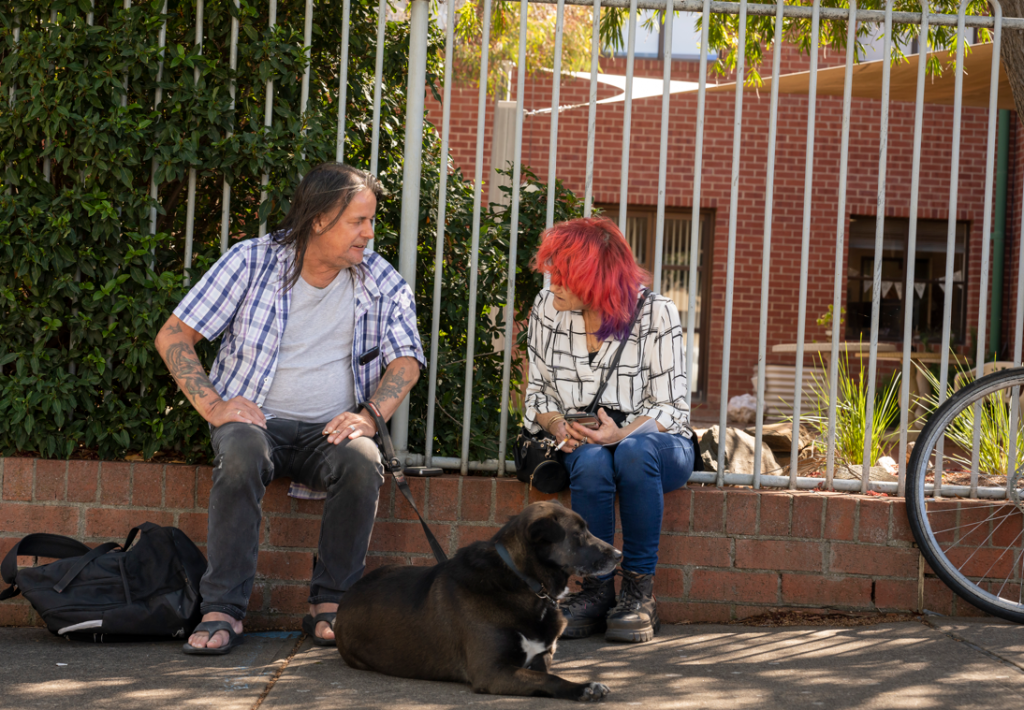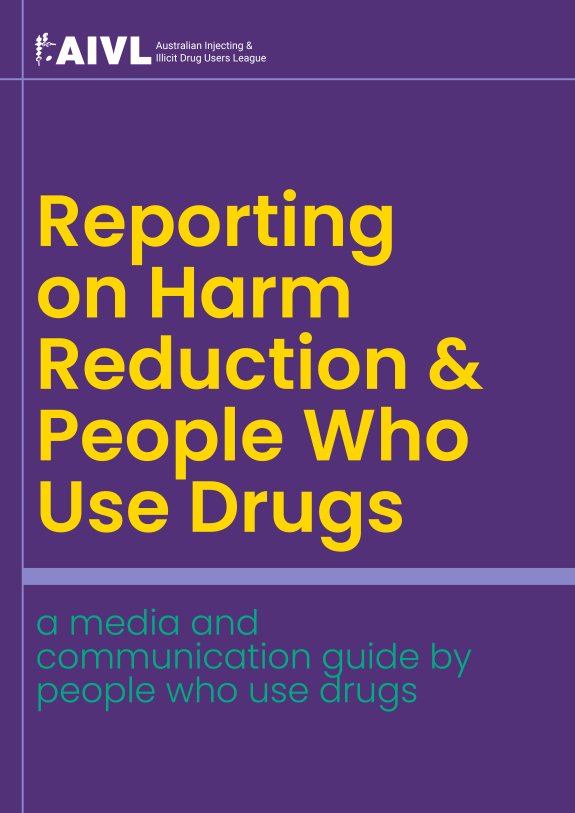
A Media and Communication Guide by People Who Use Drugs
This media and communication guide has been developed by people who use drugs using a harm reduction lens. It aims to help reporters and people writing for media ensure their coverage of people who use drugs uses respectful language, decreases inadvertent harm, avoids stereotypes, and promotes an accurate and informed narrative.
Download the Guide
10 Quick Tips for People Reporting on Harm Reduction and People Who Use Drugs
1. Use Person-First Language
When writing about people who use drugs, always use person-first language.
Person-first language emphasises that people are more than their drug use and avoids reducing individuals to labels and stereotypes, which can be harmful.
• Instead of: “Drug addicts” or using a drug name to identify someone such as “Ice user”.
• Use: “People who use drugs” or “People who inject drugs” or ”Someone who uses methamphetamine”.
This reinforces the idea that drug use is just one aspect of a person’s life and avoids the dehumanising effect of labels.
2. Avoid Judgmental and Stigmatising Terms
Certain words can carry moral judgment or imply blame. Reframe your language to avoid creating a “good vs. bad and us vs. them” narrative.
• Instead of: “Clean” when referring to a person’s drug use.
• Use: “currently not using drugs” or “person with a lived experience of using drugs” to describe a person’s relationship with drugs.
This avoids associating drug use with dirtiness or moral failing and keeps the focus on health and wellbeing.
• Instead of: “substance abuse”, “drug addiction” or “drug abuse”.
• Use: “using drugs”.
Not all drug use results in harm, and not all drug use is problematic. Using terms such as “addiction” and “abuse” creates an automatic association between drug use, harm, uncontrolled or problematic use or even violence, when none may exist.
3 Include the Voices of People Who Use Drugs
One way to humanise reporting and avoid stigmatising narratives is to include the perspectives of people who use drugs. Centering their experiences can provide a fuller picture of an issue and challenge common stereotypes. However, it is important to make sure you do not place someone in a vulnerable position. Drug use is criminalised and stigmatised, and asking someone who has little or no experience with media to talk about their own criminalised and stigmatised practices publicly could endanger or hurt them and have a negative impact on the public discourse.
Every state and territory in Australia has a harm reduction service run by and/or employing people who use drugs. The people who use drugs that work in these organisations often have experience working with media, and knowledge about the big picture issues affecting a broad range of people who use drugs. They are also more likely to be supported within their organisations and communities, should there be any difficulties that come from speaking out.
AIVL is the peak body representing these organisations nationally and can be contacted by media for public comment.
- Instead of: Relying solely on the perspectives of policymakers, clinicians, researchers or law enforcement.
- Consider: Contacting your local or national peer-based harm reduction service to interview people who use drugs that work in these organisations. Let their voices shape the story.
Including these voices reduces the “othering” effect and acknowledges people who use drugs as active participants in finding solutions while recognising the real impact of criminalisation and stigma on people who use drugs.
4. Let the Community of People Who Use Drugs Choose Their Representatives
Listen to the organisations that are led by people who use drugs about who should represent them and how they should be represented in media. Humanising stories about an individual are compelling for the reader, they don’t have to be tragic. Organisations that are led by people who use drugs are well connected to their communities of people who use drugs, employ people with broad ranges of experience, have good understandings of cultural perspectives and are well versed in current research, services and political and policy environments. They have often thought deeply about how stereotypes and narratives depicting people who use drugs as “out of control” or “needing help” can be damaging even when the overall intent is positive.
• Instead of: trying to find a person who uses drugs whose life is ‘tragic’ or someone who can speak about having had a terrible life before they stopped using drugs.
• Consider: Talk to an organisation that is led by people who use drugs and platform a person who can speak from a neutral and more representative perspective, e.g. about being a functioning person while using drugs.
Highlight human stories that are positive and show the best of people who use drugs to help dispel negative and harmful stereotypes while still being interesting to the reader.
5. Focus on Drug Use as a Public Health Issue
Frame drug use in the context of public health rather than a criminal or moral problem. Highlight harm reduction strategies as a proven way to reduce health risks and improve outcomes for individuals and the community.
• Instead of: Framing drug use as a criminal justice issue.
• Consider: Focusing on harm reduction measures like Needle and Syringe Programs (NSPs), Opioid dependence treatment (ODT), and overdose prevention tools like Naloxone that have been shown to reduce harm and save lives, as well as housing, health and social service access.
This type of framing shifts the narrative away from punishment and toward solutions that benefit the whole community including people who use and inject drugs.
6. Be Accurate and Specific When Discussing Drug Related Risks
Overstating the dangers of drug use can perpetuate myths and increase stigma. Provide accurate, evidence-based information to help your audience better understand the situation.
• Instead of: “People who use drugs are spreading diseases.” and “carelessly discarded needles are a risk to the community”.
• Use: “Without access to sterile injecting equipment, the risk of blood-borne viruses like hepatitis C increases for people who inject drugs.” and “Needle and Syringe Programs offer safe needle disposal and monitor local areas for discarded sharps, playing a vital role in the community.”
By providing specific information, you avoid scapegoating people who use drugs while educating readers on the real, preventable risks.
7. Avoid Linking Drug Use with Violence or Criminality
Media often conflates drug use with criminal behaviour or violence, which reinforces harmful stereotypes. When reporting on drug use, be clear about the context and avoid implying that drug use inherently leads to crime.
• Instead of: “Drug use is responsible for a rise in crime rates.”
• Use: “Systemic issues like poverty, housing insecurity and lack of support services can contribute to rates of crime.”
This shifts the focus from individuals to broader social issues and avoids portraying people who use drugs as inherently dangerous.
8. Highlight Harm Reduction as Part of the Solution, Not the Problem
Harm reduction measures, such as Needle and Syringe Programs, Opioid dependence treatment, Supervised Injecting/Drug Consumption Rooms and Drug Checking, are often misunderstood. Evidence shows harm reduction services play an important role in reducing costs to the health system, reducing impacts of overdose, increasing individuals access to services including drug treatment, and increasing local public amenity. Emphasise their role in protecting both individuals and the wider community.
• Instead of: “Needle exchanges encourage drug use.”
• Use: “Needle and Syringe Programs reduce the spread of blood-borne viruses and connect people to healthcare services, benefiting the entire community.”
This counters misinformation and accurately frames harm reduction programs as an essential part of a public health strategy.
9. Provide Context When Reporting on Drug Use Trends
When covering increases in drug use or overdose rates, make sure to provide context. Explain the social, economic, and health factors that contribute to these trends, rather than focusing solely on the numbers.
• Instead of: “Drug use is skyrocketing in the region.”
• Use: “Social and economic factors, such as unemployment, insecure housing and lack of mental health services, are contributing to rising rates of drug use in the region.”
This avoids sensationalising the issue and helps readers understand the broader factors at play.
10. Avoid Creating a Divide Between “Drug Users” and “The Community”
People who use drugs are part of the community. Framing them as outsiders or a threat to “the community” increases stigma.
• Instead of: “Drug users are putting the community at risk.”
• Use: “Ensuring people who use drugs have access to harm reduction services improves the wellbeing of everyone in the community.”
This approach fosters inclusivity and reduces the perception that people who use drugs are separate from the broader population.




